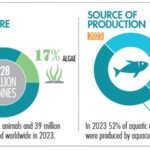UK.- 2017 was a positive year for Scottish salmon farming production according to new figures published today (Monday 15thOctober) by the Scottish Government. The Scottish Fish Farm Production Survey for 2017, produced by Marine Scotland Science, reports that 189,707 tonnes were harvested, the sector’s highest ever output.
The official annual statistical bulletin also reports increases of just over three million smolts put to sea as well other measures of productivity.The level of survival on farms has also improved to 79.1% compared to 73.3% in the previous year.
Gilpin Bradley, chairman of the Scottish Salmon Producers Organisation (SSPO) welcomed the new figures:
2017 was a successful year for Scottish salmon farmers. Volumes were strong and exports reached an all-time high with sales of £600m to more than 50 countries worldwide. This is testament to the hard work and commitment of so many dedicated salmon farmers in the Highlands and Islands and the global recognition of Scottish salmon’s enviable premium market position.
“Demand for quality Scottish salmon continues to outstrip supply and the sector aspires to grow to meet demand, but we also recognise the importance of steady, sustainable development. These new figures, alongside the investment in tackling emerging challenges give us great confidence in the sector’s ability for sustainable growth over the coming years.”
Salmon farming is significant to Scotland’s economy and it is in some of the most remote parts of the country where its value is truly felt. Highlands and Islands Enterprise recently reported that employment in the industry and the wider supply chain topped 10,000 full time equivalent jobs.
Charlotte Wright, chief executive of Highlands and Islands Enterprise said:
“These figures are good news for Scottish aquaculture and show the significant social contributions the industry makes to remote rural, island and coastal areas by supporting high-skilled jobs, diversifying and protecting communities. Salmon farming is a major contributor to the Highlands and Islands economy and brings additional business opportunities to the area. We have supported the aquaculture industry since its inception and as a vital sector which provides many jobs for rural communities.”
Stay Always Informed
Join our communities to instantly receive the most important news, reports, and analysis from the aquaculture industry.
Like other farming sectors, salmon farmers must plan for and respond to environmental challenges like warmer sea water temperatures. Ahead of an anticipated dip in production in 2018 because of gill health issues during autumn 2017, which affected salmon due for harvest in 2018, the sector is putting investment in place to help smooth fluctuations in production. There is an increased move towards the use of recirculated aquaculture systems to ensure the growth of more robust smolts, along with the installation of continuous environmental monitoring and other camera technology to closely monitor fish behaviour once at sea.
Mr. Bradley added:
“Salmon farmers have invested more than £60m in new technologies and improved farming techniques, research projects and cleanerfish to remove naturally occurring sea licewhich thrive in the warmer temperatures. Farmers continue to work hard to improve fish health and salmon survival and we are seeing benefits coming from the new innovations. It is encouraging to see that the report confirms an improvement in the industry’s survival figures as a result of the ongoing investment in this area. Farmers are leading contributors to the Scottish Government’s Farmed Fish Health Framework, the 10-year strategy for continued improvement in fish health and to encourage collaboration between industry, regulators and scientists”.
These investments signal optimism in a strong long-term future for farmed Scottish salmon, cemented by wider investments in the sector’s supply chain such as the £105m investment at Kyleakin, Skye where a 170,000 tonne fish feed facility and visitor centre is planned for build in 2019.
The industry’s commitment to continued improvement is evident in the newly established farm-by-farm reporting of sea lice levels which has shown that, on the whole, lice levels during 2018 have been the lowest they have been for 5 years.
Source: Scottish Salmon
Editor at the digital magazine AquaHoy. He holds a degree in Aquaculture Biology from the National University of Santa (UNS) and a Master’s degree in Science and Innovation Management from the Polytechnic University of Valencia, with postgraduate diplomas in Business Innovation and Innovation Management. He possesses extensive experience in the aquaculture and fisheries sector, having led the Fisheries Innovation Unit of the National Program for Innovation in Fisheries and Aquaculture (PNIPA). He has served as a senior consultant in technology watch, an innovation project formulator and advisor, and a lecturer at UNS. He is a member of the Peruvian College of Biologists and was recognized by the World Aquaculture Society (WAS) in 2016 for his contribution to aquaculture.



